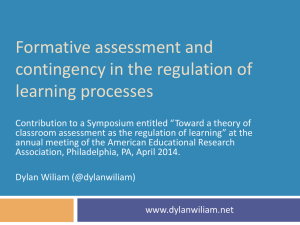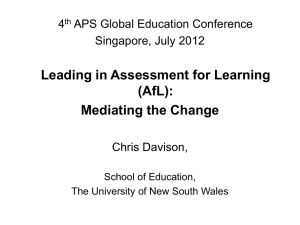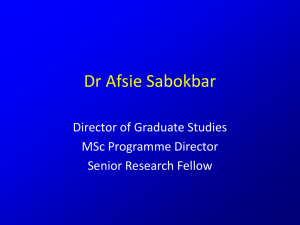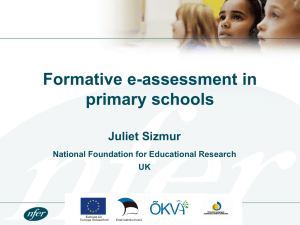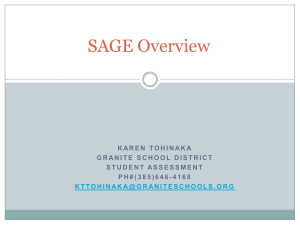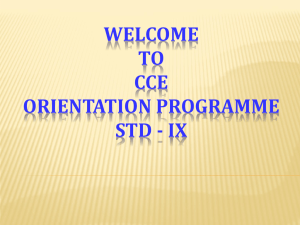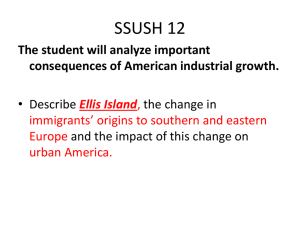Assessment for Learning culture
advertisement
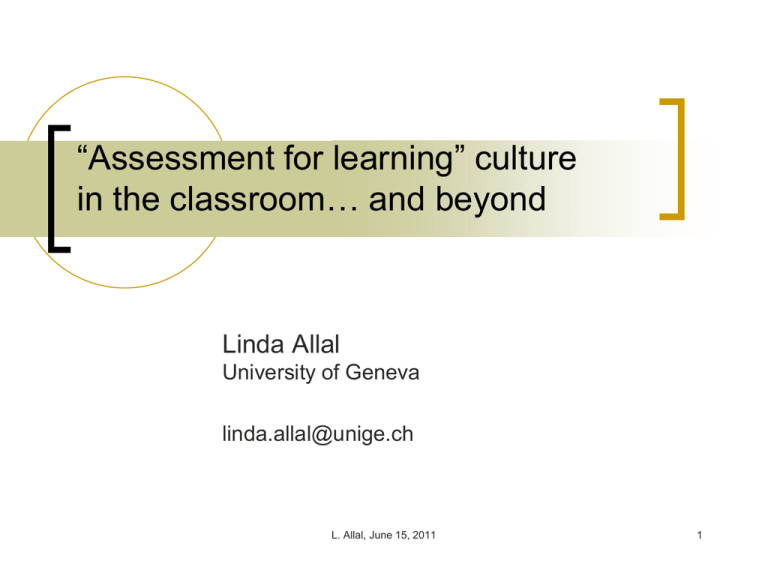
“Assessment for learning” culture in the classroom… and beyond Linda Allal University of Geneva linda.allal@unige.ch L. Allal, June 15, 2011 1 Outline 1. 2. 3. 4. Assessment for learning Assessment for learning (AfL) culture AfL culture in the classroom AfL culture… beyond the classroom L. Allal, June 15, 2011 2 1. Assessment for learning (AfL) Concept introduced by the Assessment Reform Group (ARG), UK, 1999, as a priority for classroom assessment Definition (2002): "Assessment for Learning is the process of seeking and interpreting evidence for use by learners and their teachers to decide where the learners are in their learning, where they need to go and how best to get there.” Widespread influence International network : Chester (UK), 2001; Portland (USA), 2005; Dunedin (NZ), 2009; Bergen/Solstrand (NO), 2011 Definition (2009): "Assessment for Learning is part of everyday practice by students, teachers and peers that seeks, reflects upon and responds to information from dialogue, demonstration and observation in ways that enhance ongoing learning." L. Allal, June 15, 2011 3 1.1 Key characteristics of AfL AfL is formative assessment : assures adaptation of teaching and learning activities in ways that enable students to attain intended learning outcomes (Bloom, 1968) In particular, formative assessment that: Is embedded in ongoing instructional activities Fosters active student involvement in assessment (selfassessment, peer assessment, metacognitive reflection) Concerns not only cognitive aspects of learning, but also affective and social aspects (motivation, attitudes toward learning, cooperation in learning) At the heart of AfL: “interactive” formative assessment (Allal, 1979; Allal & Pelgrims Ducrey, 2000); “informel” formative assessment (RuizPrimo, 2011) (See review by Wiliam, 2011) L. Allal, June 15, 2011 4 1.2 Assessment for vs. of learning Distinction, made from the beginning in relation to concepts introduced by Bloom et al. (1971): Assessment for learning (actively supports student learning) Formative assessment Assessment of learning (aimed at grading, reporting, accountability) Summative assessment 3rd distinction: assessment as learning L. Allal, June 15, 2011 5 1.2 Assessment for vs. of learning Limitations of this distinction: - Assessment for : a purpose or function of assessment - Assessment of : an object of assessment Assessment for learning (as a purpose) must necessarily start with assessment of one or more aspects of learning (as an object): learning progression, learning strategies, learning outcomes, attitudes towards learning,… Compatibility or even synergy between AfL and summative assessment ? (Allal, 1991; Harlan, 2005 ; Wiliam, 2000) Studies of classroom practice show there is a zone of overlap between formative and summative assessment Three cases in this interface that support student learning and can be considered as part of AfL L. Allal, June 15, 2011 6 1.3 AfL encompassing formative assessment & some cases in the formative-summative interface Classroom assessment Assessment for Learning Formative assessment Summative assessment A B C External Assessments L. Allal, June 15, 2011 7 1.3 Cases of AfL in the formative-summative interface A. Information from formative assessment taken into account in determining a summative assessment F S e.g., teacher takes into account observations of a student during math workshops, in addition to test results, when determining the student’s math grade in report card B. Information from a summative assessment is used in a formative manner S F e.g., assessments of biology reports (included in semester grades) are used to organize new instructional activities aimed at enhancing comprehension and correcting errors C. An assessment incorporates phases or components that have a formative function while leading to a summative outcome e.g., preparation of a writing portfolio, with intermediate tasks of self-assessment and peer assessment, which when finished is the basis for a final grade L. Allal, June 15, 2011 8 1.3 AfL encompassing formative assessment & some cases in the formative-summative interface Classroom assessment Assessment for Learning Formative assessment Summative assessment A B C External Assessments L. Allal, June 15, 2011 9 2. Assessment for Learning culture Two meanings of classroom culture and school culture: culture as a general, socially transmitted framework common to all/most classrooms and schools (Cuban, 1984; Gallego & Cole, 2001; Mehan, 1997) culture as a contextualized, socially constructed framework elaborated in each classroom or school (“microculture” - Erickson, 1988; Seeger et al., 1989) My focus here: Assessment for Learning culture as constructed in classroom and school settings L. Allal, June 15, 2011 10 2.1 Conceptual frameworks Shepard (2000): The role of assessment in a learning culture (social constructivist conceptions of learning) Birenbaum, Kimron & Shilton (2011) Nested relationships between: - Assessment for Learning - Classroom assessment culture - School-based professional learning community Framework for our research in Geneva: the perspective of “situated” learning and cognition - Vygotsky (1978): scaffolding and the role of tools in the mediation of learning - Wenger (1998) : dialectical relation between the individual and the social in a community of practice - Cobb et al. (1997): “taken-as-shared” meaning of concepts elaborated in classroom interactions L. Allal, June 15, 2011 11 2.2 Components of AfL culture Key components of assessment culture in a situated perspective: Assessment practices: Transactions between actors (teachers, students): face-toface interactions & indirect exchanges Roles of the actors in assessment Assessment tools: co-elaboration, appropriation “Taken-as-shared” meaning attributed to different aspects of assessment: goals, criteria, expectations, norms, values L. Allal, June 15, 2011 12 3. AfL culture in the classroom Interactive formative assessment as the foundation of AfL culture in the classroom Aspects of the interface between formative & summative assessment that contribute to AfL culture in the classroom Illustrations drawn from research in Geneva L. Allal, June 15, 2011 13 3.1 Formative AfL culture in the classroom Assessment practices Transactions between teacher and students & their respective roles Whole-class discussions Discussions of mathematical problem-solving procedures in 2 third-grade classes, observed for an entire year (Mottier Lopez & Allal, 2007) Paula’s class: the teacher carries out active scaffolding of individual student’s explanations; she evaluates all the students proposals Luke’s class: the teacher asks many open-ended questions (What to you all thing of that?); he often engages students in the evaluation of other students proposals 2 different AfL cultures: both support student learning, in different ways L. Allal, June 15, 2011 14 3.1 Formative AfL culture in the classroom Assessment practices (transactions teacher-students & roles) Excerpt Luke’s class Problem: 47 cinema tickets sold at 18 francs each Students work in pairs on finding the solution. Whole-class discussion: Several students explain that they tried adding 18 (iteratively) 47 times. Fabian announces he has found a “trick”: I counted the 47s, I put 18 times 47 Teacher: 47 tickets at 18 francs, and he, he did 18 times 47. What do you think about that? Some students agree with Fabien, others disagree:18 times 47 won’t give the same thing as 47 times 18. The teacher asks the students to explain. There are several direct exchanges between students without the teacher’s intervention. Finally, a student suggests: Well, you have to calculate it. L. Allal, June 15, 2011 15 3.1 Formative AfL culture in the classroom Assessment practices (transactions & roles) Individual teacher-student interactions: scaffolding and interactive regulation in the learner’s ZPD; adjustment of the task allows a student with learning difficulties to participate in a classroom writing project (Allal & Pelgrims Ducrey, 2000) Peer interactions in small groups: 5th-grade students’ text revision is enhanced through their participation in practices of peer assessment, i.e., reciprocal and joint revision of the drafts produced by the students (Allal et al., 2005) , L. Allal, June 15, 2011 16 3.1 Formative AfL culture in the classroom Assessment tools Co-elaboration of tools Interactive elaboration of a Writing Guide and subsequent text production and revision carried out by the students in 3 fifth-grade classes (Allal et al., 2005) In the class with the most active student involvement in the elaboration of the guide and in brainstorming of ideas, the students subsequently carried out more advanced forms of text revision (more transformations of semantics and text organization, in addition to correction of spelling) Appropriation of tools provided by the teacher, the curriculum L. Allal, June 15, 2011 , 17 3.1 Formative AfL culture in the classroom Taken-as-shared meaning (student roles) Emergence of “sociomathematical norms” that govern student participation during in whole-class discussions of problem solving (Mottier Lopez & Allal, 2007) Norms common to both classes: Ex., Propose and explain a different procedure than those already given by other students Norm specific to Paula’s class: Ex., Re-explain or pursue the explanation of another student’s procedure Norm specific to Luke’s class: Ex., Express opinions about other students’ proposals, their relevance and effectiveness L. Allal, June 15, 2011 18 3.2 Summative-formative interface & AfL culture Assessment practices Analysis of 10 sixth-grade teachers’ practices regarding the determination of grades and comments in student report cards: focus on “borderline” cases that reveal how teachers’ professional judgment is formulated (Allal & Mottier Lopez, 2008) Teachers’ aim: establish the most valid assessment possible of student competency with respect to curriculum objectives by taking into account not only test results but also other sources of information (often from formative assessments) Teachers’ use of information in the report card: a basis for discussions with students and parents about the students’ future, about how to attain their goals (a “macro-formative” use of summative data) L. Allal, June 15, 2011 19 3.2 Summative-formative interface & AfL culture Example: Grading practices of Alice To determine Karim’s second trimester math grade, Alice takes into account: Classroom test results: variable, from excellent…to totally insufficient Daily records: investment often minimal (esp. homework) Informal observations from math workshops: understands math concepts quickly Summative tests Information from formative assessments Discussions with Karim “He has dreams, he says he’d like to become a doctor, but at the same time he doesn’t invest much in his schoolwork.” L. Allal, June 15, 2011 20 3.2 Summative-formative interface & AfL culture Example: Grading practices of Alice (cont.) Karim’s grade is recorded in his report card Alice has a discussion with Karim about his grades in relation with what he wants to do next year (7th grade) or in the future and how to achieve his goals: Despite recurrent family problems, how can you set aside time and space for homework? Is there a way to use time at school to get ahead on homework? How important is math if you want to become a doctor? What is required to enter and stay in the academic track of secondary studies? L. Allal, June 15, 2011 Summative reporting Use of summative data in a discussion with a “macro-formative” purpose 21 3.2 Summative-formative interface & AfL culture Taken-as-shared meaning Example: meaning of “fairness” in assessment Classroom forum: meets each week to discuss and solve problems; each class member can submit questions or problems (anonymously) Alice submits the question: “Does the teacher have favorites?” discussion about “fairness” in assessment (especially summative assessment): - signs of favoritism & confrontation of interpretations - taking into account differences among students while still assuring fair and equitable assessment , L. Allal, June 15, 2011 22 4. AfL culture… beyond the classroom Beyond the classroom, 3 major influences on teachers’ practice of Assessment for Learning: The school’s culture of assessment The values promoted by the teachers’ professional association The policies adopted by the school system , L. Allal, June 15, 2011 23 4.1 School assessment culture Aspects of school culture that support teachers’ practice of Assessment for Learning: Elaboration of shared conceptions of assessment and their communication to parents Open dialogue about assessment problems, about difficulties encountered with students and with parents School-based professional development activities based on analysis of assessment practices Development of school projects promoting formative assessment and qualitative aspects of summative assessment L. Allal, June 15, 2011 24 4.1 School assessment culture Examples from Alice’s elementary school Assessment practices, tools & values Shared decision to not give grades on tests and class work; common explanation given to parents by each teacher Shared instruments: Files in the teachers’ meeting room with all the summative tests used in the different classes Periodic meetings (of teachers, school nurse, psychologist, school director) to discuss the situation of students who encounter particular difficulties and the ways to support their learning and well being A school-wide perspective on assessment: It is important to take into account differences among students while still assuring equity of assessment L. Allal, June 15, 2011 25 4.2 Values promoted by teachers’ professional associations Position papers & Code of deontology can support: Emergence of AfL culture in schools Individual teachers’ practice of AfL (in schools where AfL culture is absent or weakly established) Example: items from the Code of deontology of the Teachers’ Association of French-speaking Switzerland “The teacher: Presents clearly her/his pedagogical objectives and is able to adapt them, if necessary, to the particular situation of the student Undertakes all appropriate actions to assure the optimal development of each student Demonstrates critical thinking, autonomy, and a sense of responsibility Works to promote collaboration with colleagues and others in her/his school…” L. Allal, June 15, 2011 26 4.3 Influence of policy on AfL culture Resources provided by the school system that can support AfL: school-based professional development resources for school initiated projects participation of teachers in research projects Constraints imposed by the school system that can support AfL: grading systems and report cards that allow a place for teachers’ professional judgment guidelines that encourage formative assessment and forms of summative assessment that contribute to learning curriculum objectives that prepare students for the future and are attainable L. Allal, June 15, 2011 27 Conclusion: AfL culture in a socially situated perspective School system resources & constraints: curriculum objectives, guidelines, in-service ed. School assessment culture Classroom assessment culture Professional association: deontology Assessment for Learning culture practices (transactions, roles), tools, taken-as-shared meaning L. Allal, June 15, 2011 28 Thank you linda.allal@unige.ch L. Allal, June 15, 2011 29
